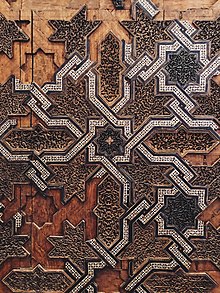

You can help expand this article with text translated from the corresponding article in Arabic. (May 2020) Click [show] for important translation instructions. Content in this edit is translated from the existing Arabic Wikipedia article at [[:ar:علي بن يوسف بن تاشفين]]; see its history for attribution.{{Translated|ar|علي بن يوسف بن تاشفين}} to the talk page. |
| Ali ibn Yusuf | |||||
|---|---|---|---|---|---|
| Amir Al-Muslimin | |||||

Gold dinar minted by Ali ibn Yusuf
| |||||
| Amir of the Almoravids | |||||
| Reign | 1106–1143 | ||||
| Predecessor | Yusuf ibn Tashfin | ||||
| Successor | Tashfin ibn Ali | ||||
| |||||
| Born | c. 1084 Ceuta | ||||
| Died | 28 January 1143 | ||||
| Issue | Tashfin ibn Ali Syr ibn Ali Ishaq ibn Ali Zaynab bint Ali[1] | ||||
| |||||
| Dynasty | Almoravid | ||||
| Father | Yusuf ibn Tashfin | ||||
| Mother | Zaynab an-Nafzawiyyah or Qamar | ||||
| Religion | Islam | ||||
Ali ibn Yusuf (also known as "Ali Ben Youssef") (Arabic: علي بن يوسف) (c. 1084 – 28 January 1143) was the 5th Almoravid emir. He reigned from 1106 to 1143.
Ali ibn Yusuf was born in 1084–1085 (477 AH) in Ceuta.[2] He was the son of Yusuf ibn Tashfin, the fourth Almoravid ruler. According to some sources, his mother was Zaynab an-Nafzawiyyah.[3][4][dead link] According to some others, his mother was Qamar or Qamra, surnamed Fadl al-Hasan,[2][5]aChristian captive from al-Andalus who became Yusuf's concubine.[2] A woman Qamar is also cited by some sources as Ali Ibn Yusuf's own concubine[6][7] and the mother of his son Syr.[6]
At the time of his father's death, in September 1106, he was 23 years old. He succeeded his father on 2 September 1106.[8][9] Ali ruled from Morocco and appointed his brother Tamim ibn Yusuf [ar] as governor of Al-Andalus. Ali expanded his territories in the Iberian Peninsula by capturing the Taifa of Zaragoza in 1110 but eventually lost it again to Alfonso I, King of Aragon, in 1118. Córdoba rebelled against the Almoravids in 1121.
In 1139, he lost the Battle of Ourique against the Portuguese forces led by the count Afonso Henriques, which allowed Afonso to proclaim himself an independent King.
Ali died on 28 January 1143 and was succeeded by his son Tashfin ibn Ali.[10]


He commissioned a minbar now known as the Minbar of the Kutubiyya Mosque from a workshop in Córdoba to furnish his grand mosque, the original Ben Youssef Mosque (destroyed under the Almohads), in the imperial capital, Marrakesh.[12] The Almoravid Qubba also bears Ali's name.[11]
At the advice of Abu Walid Ibn Rushd (grandfather of Averroes), Ali built walls around Marrakesh as Ibn Tumart became more influential.[13][14] There had been walls around the mosque and the palace, but Ali ibn Yūsuf spent 70,000 gold dinars on the city's fortifications, doubling the city's size, and told the amirsofAl-Andalus to fortify their walls as well.[15]
He also established an irrigation system in Marrakesh, a project managed by Obeyd Allah ibn Younous al-Muhandes.[16] This irrigation system made use of qanawat (قناة, p. قنوات).[16] Ali also had the first bridge over the Tensift River built.[16]

According to the Muslim cartographer Muhammad al-Idrisi, the Mugharrarin (also translated as "the adventurers") sent by Ali ibn Yusuf, led by his admiral Ahmad ibn Umar, better known under the name of Raqsh al-Auzz reached a part of the ocean covered by seaweed, identified by some as the Sargasso Sea,[18] which stretches into the Atlantic from Bermuda.
Ali was the son of Yusuf ibn Tashfin. He had at least two sons:
Zaynab bint Ali ibn Yusuf
Yusuf ibn Tasufin,... , married Zaynab an-Nafzawiyyah with whom he had three children: Ali ibn Yusuf, Abu Abdallah Muhammad ibn Aisa and Tamima bint Yusuf ibn Tashfin
Zeineb and Yusef ibn Tashfin had a son, Ali ibn Yusef ibn Tashfin, who is described as having an excellent character. He ruled until 1142–3 CE/537 AH. He was succeeded by Tashfin ibn Ali ibn Yusef ibn Tashfin. Legitimacy still passed through her even though her name was no longer affixed to his, at least in this account...Ghania's sons were raised under the patronage and supervision of Ali Ibn (Zeineb and) Yusef Ibn Tashfin
one example of a powerful concubine was Qamar, the mother of Sir, one of 'Ali b. Yusuf's sons
Qamar, 'Ali's favorite concubine...
| Preceded by | Almoravids 1106–1143 |
Succeeded by |
| International |
|
|---|---|
| National |
|
| Other |
|
This biography of a member of a noble house or article about nobility is a stub. You can help Wikipedia by expanding it. |
This biographical article about a person notable in connection with Islam is a stub. You can help Wikipedia by expanding it. |